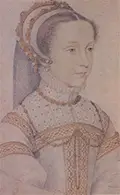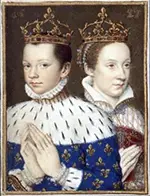Mary, Queen of Scots
Part 1: Scotland, France, and England Mary, Queen of Scots ruled over a troubled realm in the 16th Century and ultimately lost her life after being convicted of plotting to overthrown another monarch. She was born on Dec. 8, 1542, at Linlithgow Palace, in Scotland. Her father was the reigning monarch, King James V, and her mother was Mary of Guise. Six days after Mary was born, her father died. He had not been present at her birth, having lost a significant battle against English force at Solway Moss a few weeks earlier. Mary was James's oldest child, and so she was the heir apparent. When he died, she became the leader of Scotland. 
Because Mary was so young, she was technically queen of the realm but, in reality, the rule of Scotland was done by a regent. Echoing the tensions found in England between the two faiths, Scotland had a regency that was claimed by two strong men. One was David Beaton, a Cardinal in the Catholic Church; the other was James Hamilton, Earl of Arran, a Protestant who could trace his lineage directly back to King James II. Arran won the power struggle and became Governor and Protector of Scotland. England's King Henry VIII proposed that his young son, Edward (who was then 6), marry Mary, in order to seal an alliance between the two oft-warring lands. The necessary agreements were made, and both sides signed the Treaty of Greenwich in July 1543. Scotland had promised that when Mary was 10, she would marry Edward and move to England. Mary was crowned on September 9. After a handful of disagreements and some provocative actions by Henry VIII, the Scottish Parliament rejected the Treaty of Greenwich, which meant that the marriage was off. Angry, Henry sent troops north to enforce what he saw as a royal commandment to have a royal marriage. The unrest continued for several years, and Scottish forces moved young Mary around the country in order to keep her safe. Henry VIII died in 1547, and young Edward succeeded him on the English throne. The war between England and Scotland continued for a time. The French king, Henry II, had offered his young son as a marriage match for Mary in 1548. Scotland accepted this alliance, and French troops arrived in Scotland to help relieve an English siege. The fighting stopped in 1551. Meanwhile, Mary was living at the French court. She learned to play the lute and the keyboard, studied literature, and learned falconry and horsemanship. She also learned to speak and write French, Greek, Italian, Latin, and Spanish. She survived a bout with smallpox but was otherwise healthy. 
In April 1558, Mary and Francis, the French king's son, were married. Later that year, England's Queen Mary died and was succeeded by her sister, Elizabeth. Tensions between Catholics and Protestants arose again because Mary had been a Catholic but Elizabeth was a Protestant. Many Catholics in England, France, and Scotland viewed Elizabeth as a usurper, with an illegitimate claim to the throne. Indeed, her own father had declared her illegitimate when he finally had a son. Henry changed his mind on this before he died and named his daughters as his legitimate heirs, and this is how Mary was able to succeed Edward VI on the throne so easily. But the Catholic populations of the three countries wanted to see another Catholic on the throne of England and thought that the one who should succeed Queen Mary of England was Queen Mary of Scotland. Next page > Shattered Dreams > Page 1 2 |
|
Social Studies for Kids
copyright 2002–2025
David White




